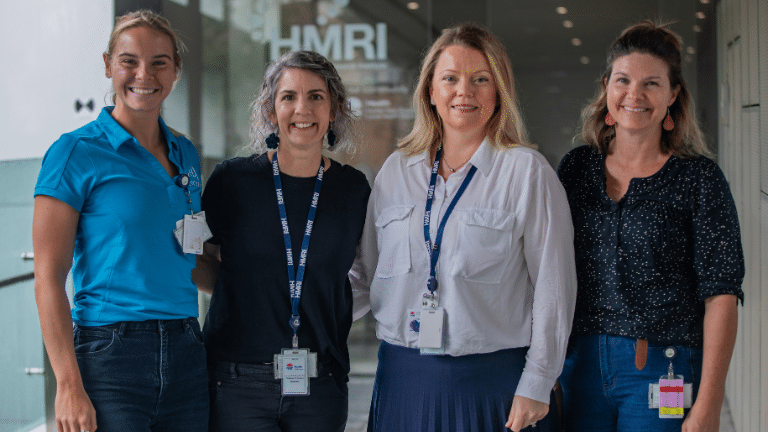
HMRI is part of a world-first study called Prevent Prem that aims to develop a tool to predict who is at risk of preterm birth and put interventions into place early.

HMRI research midwives, Libby Jones, Skye Doel, Ellisa Sexton, and Bridget McCleery
This world-first study is being conducted by Maternal Fetal Medicine Specialists at three hospitals in Australia, Professor Craig Pennell, John Hunter Hospital/University of Newcastle/HMRI Newcastle, NSW, Professor Jon Hyett, Liverpool Hospital Sydney/Western Sydney University, NSW, and Professor Fabricio Da Silva Costa, Gold Coast University Hospital/Griffith University, Qld.
Research Midwife Bridget McCleery says, “Preterm birth happens when a baby is born before 37 weeks of pregnancy and affects approximately 1 in 10 births. Around 27,000 families every year in Australia have a premature baby and this can be very stressful for parents. Some preterm births are because of medical reasons and are carefully planned by medical professionals to keep the baby safe. Others happen spontaneously when a mother goes into labour early.
Unfortunately, we do not have a reliable test to predict who will go into preterm labour unexpectedly. Being able to predict spontaneous preterm birth is important, as there are treatments available which can reduce the risk of going into labour early. If we can identify who needs these treatments in the first trimester of pregnancy, we hope to reduce the number of babies born preterm in Australia and potentially worldwide.”
The Prevent Prem study takes blood from a high-risk population (women who are in threatened premature labour), as well as an unselected population (people who are 11 – 14 weeks’ gestation with no known risk).
The idea is to test the blood to find out if there is a difference between high-risk and ‘normal’ pregnancies, and then develop an early detection test to ensure that women who are high-risk have the necessary support around them.
Bridget says, “The impact of preterm birth on women, and their families, is enormous. The emotional stress cannot be measured. Often these women have finished work much earlier than they may have planned and are using their precious maternity leave while their babies are still in hospital. Sometimes these babies don’t survive”.
“Economically this is huge. The cost to the healthcare system is massive. The babies may be in intensive care or special care nursery for weeks or months. The women may have been in hospital for some time even before they birth.”
“Often these families have other children at home and it’s very difficult to spend the time they need with their premature infants and their siblings.
“There are so many factors involved and so many potential health problems that may occur for these infants, not to mention the impact on breastfeeding, bonding and mental health for the mother and family,” says Bridget.
There are some great resources available for these women including social workers, lactation consultants and premature birth groups in the community or on social media. For the Dads, there is a great resource called SMS4Dads.
HMRI would like to acknowledge the Traditional Custodians of the land on which we work and live, the Awabakal and Worimi peoples, and pay our respects to Elders past and present. We recognise and respect their cultural heritage and beliefs and their continued connection to their land.

Hunter Medical Research Institute
We’re taking healthy further.
Locked Bag 1000
New Lambton
NSW, Australia, 2305



This site is protected by reCAPTCHA and the Google Privacy Policy and Terms of Service apply.
Copyright © 2024 Hunter Medical Research Institute | ABN: 27 081 436 919
Site by Marlin Communications
